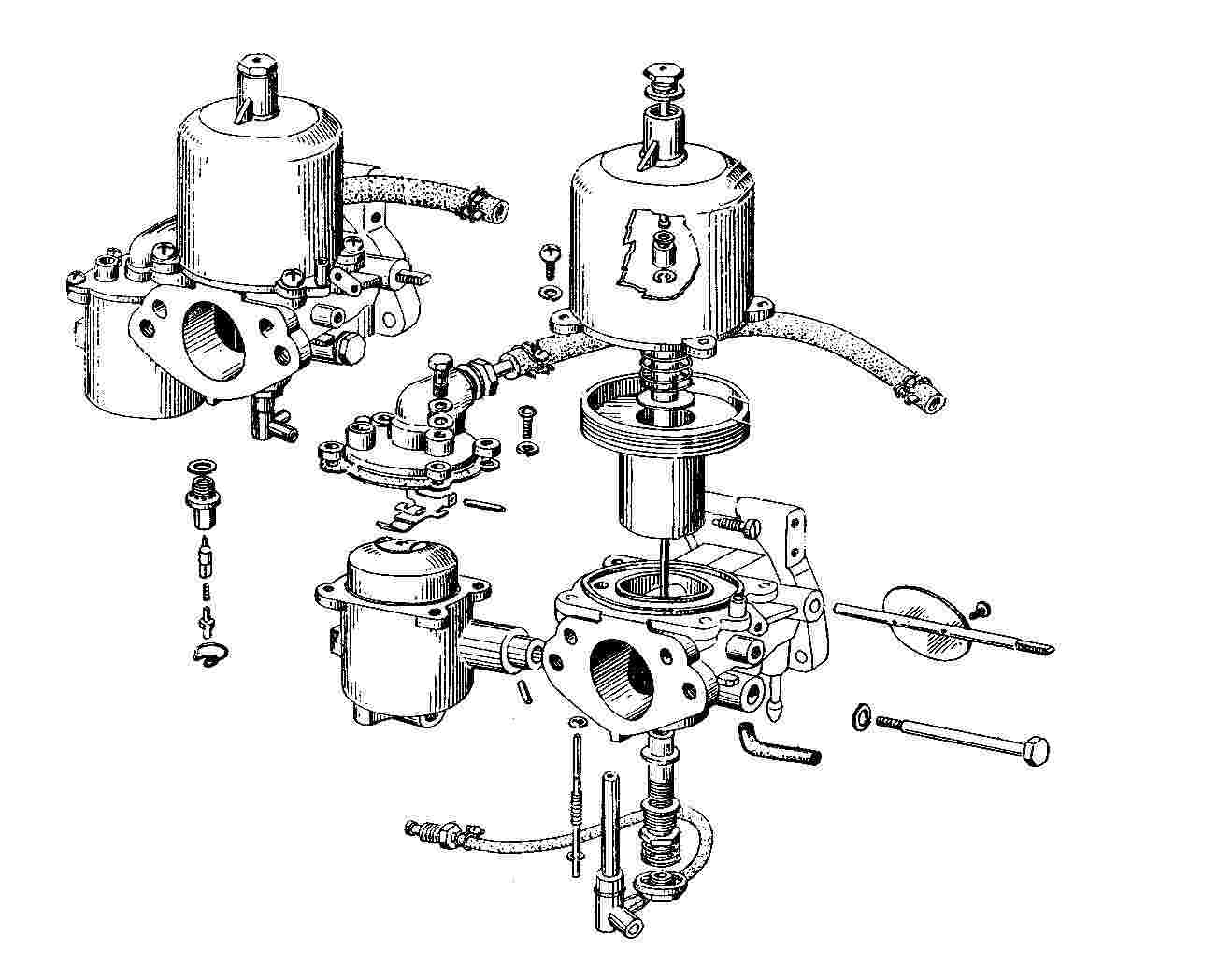Published 2007 Updated 2021

HITACHI SU CARBURATOR
311 Engine Hitachi SU 1600 Carburetor Section
Before messing with the carburetors' make sure everything else is in order i.e. air filter, ignition timing(points, rotor, cap, plug wires, and plugs.) Valve adjustment and last but not least a compression check. Once the carbs are set properly you should not have to touch them for a long, long time. So you have checked all of the above and everything appears fine.
First things to check before you start adjusting the carbs. Is there oil in the dashpots? I use ATF in mine. A light 20 WT oil is recommended. Some people highly recommend Marvel Mystery oil. Dry dashpots can and will cause you acceleration problems. If you have fuel flowing out one or both of the overflow tubes the cause may be a sunk float or debri stuck in the valve located in the float cover. It is a good idea to have a couple of spare float cover gaskets as they tear easily.
So it has come down to the fact that the carbs really do need adjusting. Well, do not fret as it is not as hard as some people make it out to be. SUs are pretty basic carbs and there are not a lot of moving parts.
First thing we want to do is remove the air cleaner assembly. Next, disconnect the throttle connections of both carburetors. On the front carb (closest to the radiator) set the idle screw so that the tachometer reading is 500 to 650 RPM. If you do not have a uni-syn, use a length of 1/2" rubber hose and place one end at the opening of the front carburetor, and the other end at your ear. Listen to the sound of the air entering the carburetor.
Move to the back carburetor and follow the same procedure of listening to the air entering the carburetor. The sound should be the same as the front carburetor to have them in synch.
Now check the tachometer to see if it has changed. Adjustments are made to both idle screws until you have both carburetors hissing the same at around 650 RPM. This completes the synchronization of the throttle opening of the dual carburetors.
Next, we need to adjust and synchronize the fuel flow to both carbs. Starting again with the **front** carb with engine running around 600 RPMs, lift the the piston of the **back** carb around 1/2". This makes the **back** carb inoperative. If the engine stalls, then you must richen the **front** carb until it keeps the engine running as if it were only firing on two cylinders. Rough is okay but you want it to be steady. Adjustments are made to the very bottom nut on the carb. Clockwise to richen-counter clockwise lean. Now, repeat this procedure of lifting the piston on the **front** carb and adjusting the **rear** carb.
You have now successfully adjusted your air fuel ratio for both carbs. You may find that when this step has been completed the RPM has increased. Go back to the idle screw of both carbs and adjust to correct your idle to 600 RPMs.
The last thing you want to do is adjust your throttle linkage connecting the carbs with throttle shaft located on the intake manifold. Adjust the length of the throttle link so that it will snap in place without changing the RPM on the front carb. Do the same adjustment for the rear carb. Your engine should now run smoothly if it is properly tuned.
You may also use a uni-syn to adjust the throttle openings and then complete the rest of the steps the same way. A uni-syn is a device with a tube and ball attached to it. You place the uni-syn in front of the carb and set the uni-syn by rotating a thumb wheel to set the ball at or close to a mark on the tube. Once it is set for one carb place it on the other carb and adjust the air flow adjusting screw on the other carb so that the ball is at the same mark as the first carb. Pretty simple really. I prefer the tube to the ear myself but do have a uni-syn as well.
There is another good tip a friend passed on to me regarding the SU carburetors. It is relatively easy and takes the guessing out of setting the initial idle mixture. You will need a caliper to perform this little gem but trust me it is the best way to set them. I will take you through the process step by step.
Step One: Remove air filter housing including backing plate. This will allow easier access to the idler adjusting nuts on the bottom of each carb.
Step Two: Remove the dashpot covers, springs, and plungers with needles from each carburetor. Make note of which one is front and back. Be careful of the needles as they damage easily.
Step Three: Peer down into the center of the opening and you will notice two brass pieces. The center one is the one we are going to set and it should be slightly below the outer brass piece already. You could take the caliper and check the heights before you begin. I did this on mine and they were surprisingly equal-not bad for doing the adjustment by feel.
Step Four: The magic number for the 1600 SUs is 0.087 in. or 0.09 in. Since you have already checked the settings you should know whether you need to lower or raise the idle mixture adjusting nut. Raise or lower to meet the magic number. Do this to both carburetors until they are both set to the magic number.
NOTE: I tried this setting on my stroker with the 2 liter SUs and it was too rich. I ended up using 0.06 in on them. That is with the stock 2 liter needles.
Step Five: Put the plunger/needles. springs and dash pot covers back in place. Fire the car up and see how it idles. Mine was idling perfectly so I did not touch them further. If you need to richen the mixture up-note the current place the little bump is on the idle adjusting screw. This will help you keep the carbs equal when making adjustments. Or you could get one set pull everything off again, take a measurement, and set the other one with the caliper.
Step Five: Put the air cleaner assembly back on to the carburetors and go for a spin. I was impressed with the results. Your results may vary but it definitely does work.
SU Links
[[http://www.ztherapy.com | ZTherapy-Rebuilder of SUs-Steve Epperly and Pam Kirmeier [[http://datsunroadsterranch.com/ | Keith Williams-rebuilds SUs in his spare time-Visit Keith's Roadster Ranch
